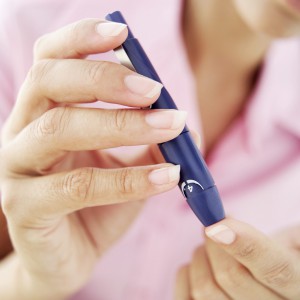I was recently diagnosed with Type 2 Diabetes…
 You have recently recognised that your waist circumference is growing, you stopped exercising long ago due to work and family commitments, and regularly eating healthy meals is something of the past. You recently went to your doctor where you were diagnosed with Type 2 Diabetes. You have heard increasing things about diabetes and know that it is growing in prevalence in Australia. In fact, some of your friends have also been diagnosed with it. Your doctor tells you that, because your blood sugar is not being controlled, you will have to start taking tablets and that your blood pressure is also of concern. He informs you that the long term complications of diabetes can include amputations, the loss of eye sight, heart disease, and kidney disease. Your doctor advises you to remove stress from your life, starting by eating a healthy diet and exercising! You leave the doctor’s office unsure of what to do next.
You have recently recognised that your waist circumference is growing, you stopped exercising long ago due to work and family commitments, and regularly eating healthy meals is something of the past. You recently went to your doctor where you were diagnosed with Type 2 Diabetes. You have heard increasing things about diabetes and know that it is growing in prevalence in Australia. In fact, some of your friends have also been diagnosed with it. Your doctor tells you that, because your blood sugar is not being controlled, you will have to start taking tablets and that your blood pressure is also of concern. He informs you that the long term complications of diabetes can include amputations, the loss of eye sight, heart disease, and kidney disease. Your doctor advises you to remove stress from your life, starting by eating a healthy diet and exercising! You leave the doctor’s office unsure of what to do next.
The question in your mind is: how do I exercise and change my lifestyle, safely and effectively, to improve my recent diagnosis?
Why should I seek professional advice?
In our Exercise Physiology Clinic, we have many people like yourself who come to us for help. The first, and hardest, step has already been made: seeking expert advice and guidance in managing your condition. We have a specifically-developed Diabetes Management Program for you. We give you the tools to better manage your lifestyle.
How can Inspire Fitness Exercise Physiology help you?
 At Inspire Fitness, we start with educating you better on the importance your condition. Though you may not feel any different and may not have been hospitalised, it’s crucial to treat your diabetes SERIOUSLY! The evidence suggests that people with diabetes are at a greater risk of suffering a heart attack than someone without diabetes who has already had a heart attack. Incredibly, diabetes is associated with a four-fold increase in heart disease!
At Inspire Fitness, we start with educating you better on the importance your condition. Though you may not feel any different and may not have been hospitalised, it’s crucial to treat your diabetes SERIOUSLY! The evidence suggests that people with diabetes are at a greater risk of suffering a heart attack than someone without diabetes who has already had a heart attack. Incredibly, diabetes is associated with a four-fold increase in heart disease!
So why do you have Type 2 diabetes? This form of diabetes generally develops as a result of a sedentary lifestyle involving a lack of exercise, poor dietary habits, a large waist circumference (80 cm or greater for women, 94 cm or greater for men, according to the Shape Up Australia government initiative), and a family history of diabetes. With diabetes, your body is not effectively dealing with sugar consumed, causing high levels to be present in your bloodstream. There can be a defect in your insulin action or in the sensitivity of your muscles to insulin (insulin is a hormone that triggers the removal of sugar from the blood). This problem can continue to get worse, until you have to inject insulin into your stomach everyday, in addition to pricking your finger upwards of 3 times per day to closely monitor your sugar levels. However, by seeking professional advice and assistance, you have made the all-important first step towards successful diabetes management, and this problem is unlikely to get worse if you continue on this path.
How do I improve my condition through exercise?
 To begin with, we assess your capacity to exercise, conduct screening for any other risk factors, and set some clear goals for your long-term health. From the information we obtain in this process, an individualised exercise program is developed to suit your fitness, your goals, and your situation. The components of the program are explained to you in conjunction with further education and exercise, taking place in a small group session that will be attended by others with diabetes. The education sessions will enable you to understand your condition, giving you the necessary tools to self-manage your diabetes through diet and exercise. You will also be kept up to date with the latest research and knowledge in the area of diabetes management.
To begin with, we assess your capacity to exercise, conduct screening for any other risk factors, and set some clear goals for your long-term health. From the information we obtain in this process, an individualised exercise program is developed to suit your fitness, your goals, and your situation. The components of the program are explained to you in conjunction with further education and exercise, taking place in a small group session that will be attended by others with diabetes. The education sessions will enable you to understand your condition, giving you the necessary tools to self-manage your diabetes through diet and exercise. You will also be kept up to date with the latest research and knowledge in the area of diabetes management.
The exercise component of the Diabetes Management Program involves both aerobic and resistance training. The aerobic training will involve moderate- to- high-intensity sessions including walking, riding, and even rowing (depending on your level of fitness). Resistance training will involve 8-10 exercises targeting the major muscle groups to build your strength, enhance your stability and balance, and improve your posture. At Inspire Fitness, we recognise that posture, stability, and performing exercises correctly are the most important aspects of resistance training. Thus, a strong emphasis is placed on these elements of your training. You will be given a home exercise program so that you can gain optimal benefits for your diabetes. We recommend that you need to undertake at least 150 mins aerobic exercise per week (which can be simply walking regularly), as well as completing at least 1 resistance training session per week. You will be supported through all of these changes to your life by our Exercise Physiology team and by the members of your group.
At the end of the eight-week, group-based Diabetes Management Program you will be feeling great, in control of your lifestyle, and ready to keep progressing under our continued supervision. Congratulations on taking this essential first step, the hardest of many forward steps in your successful, long-term health journey.
